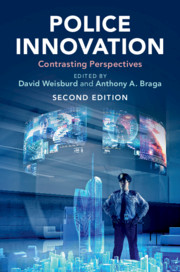Book contents
- Police Innovation
- Police Innovation
- Copyright page
- Contents
- Figures
- Tables
- Notes on Contributors
- Introduction
- Part I Community Policing
- Part II Procedural Justice Policing
- Part III Broken Windows Policing
- Part IV Problem–Oriented Policing
- Part V Pulling Levers (Focused Deterrence) Policing
- Part VI Third–Party Policing
- Part VII Hot Spots Policing
- Part VIII Predictive Policing
- Part IX CompStat
- Part X Evidence-Based/ Risk-Focused Policing
- Part XI Technology Policing
- Index
- References
Part IX - CompStat
Published online by Cambridge University Press: 09 August 2019
- Police Innovation
- Police Innovation
- Copyright page
- Contents
- Figures
- Tables
- Notes on Contributors
- Introduction
- Part I Community Policing
- Part II Procedural Justice Policing
- Part III Broken Windows Policing
- Part IV Problem–Oriented Policing
- Part V Pulling Levers (Focused Deterrence) Policing
- Part VI Third–Party Policing
- Part VII Hot Spots Policing
- Part VIII Predictive Policing
- Part IX CompStat
- Part X Evidence-Based/ Risk-Focused Policing
- Part XI Technology Policing
- Index
- References
Summary
CompStat tributes are extensive. Compstat has been described as “perhaps the single most important organizational/administrative innovation in policing during the latter half of the 20th century” (Kelling & Sousa, 2001: 6). A Criminology and Public Policy journal editor termed Compstat “arguably one of the most significant strategic innovations in policing in the last couple of decades” (Weisburd et al., 2003: 419). The authors of a major study note that Compstat “has already been recognized as a major innovation in American policing” (Weisburd et al., 2003: 422). In 1996, Compstat was awarded the prestigious Innovations in American Government Award from the Ford Foundation and the John F. Kennedy School of Government at Harvard University. Former New York City Mayor Giuliani proclaimed Compstat as his administration’s “crown jewel” (Giuliani, 2002: 7).
- Type
- Chapter
- Information
- Police InnovationContrasting Perspectives, pp. 397 - 436Publisher: Cambridge University PressPrint publication year: 2019

